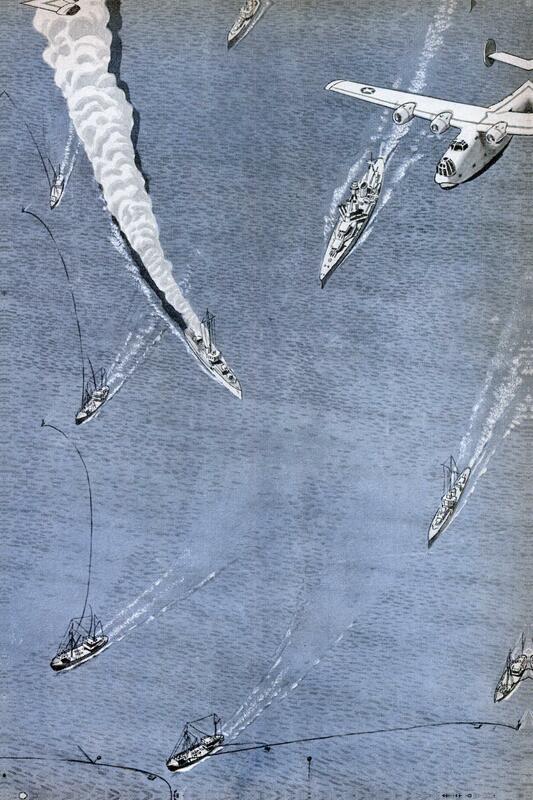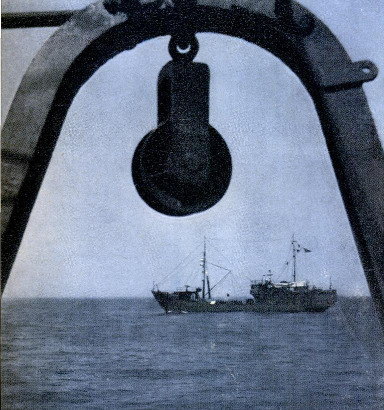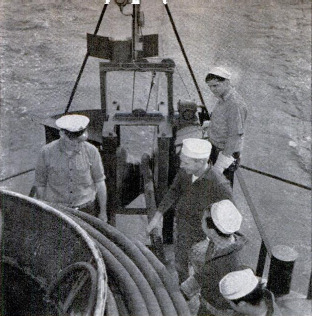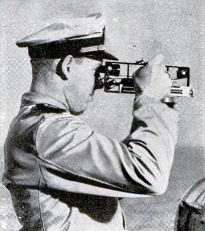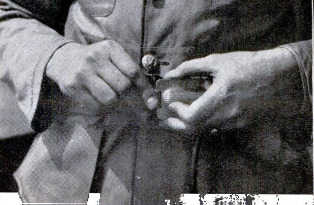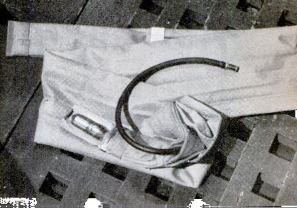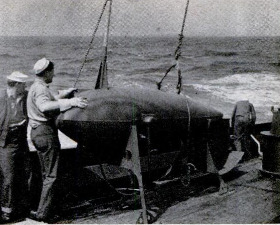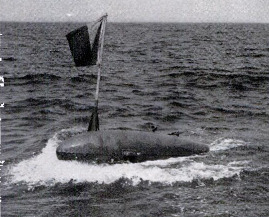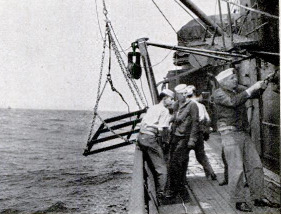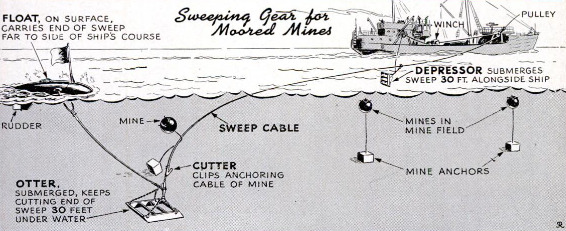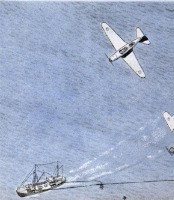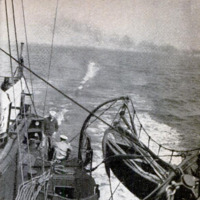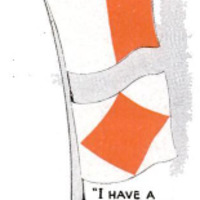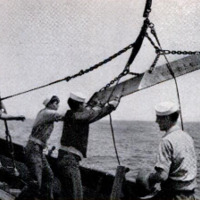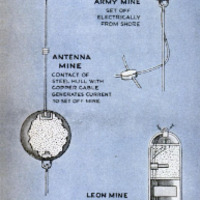-
Title (Dublin Core)
-
Fighting the submarine mine: how navies combat a deadly sea weapon
-
Article Title and/or Image Caption (Dublin Core)
-
Title: Fighting the submarine mine: how navies combat a deadly sea weapon
-
extracted text (Extract Text)
-
THE principle of the submarine mine was
mented by Sergeant Bushnell of the
American Revolutionary Army over 160
years ago. Bushnell was the inventor of a
submarine boat called the Turtle, but before
he could make this boat a practical weapon
of war, he had to prove the possibility of
exploding gunpowder under water with de-
structive effect, which he succeeded in do-
ing. Bushnell therefore was the originator,
not only of the torpedo boat, both surface
and submerged, but also of the submarine
mine.
Mining in war is for the purpose of deny-
ing the navigable seas to the ships of an
enemy. Its ends are both offensive and de-
fensive. Offensive mining is resorted to for
closing the coasts of an enemy and his har-
bors to the passage of ships. Defensive min-
ing has as its object to keep
enemy ships at a distance from
our own coasts and harbors.
‘The hulls of ships have al-
ways been most vulnerable to
underwater explosions. It has
been found impractical to pro-
tect the underwater hulls of
ships as is done to the above-
water sides, through heavier
plating and armor. A mine ex-
plosion today that blows a
large hole in a ship usually ac-
complishes its destruction.
Therefore all nations at war
are most concerned over the
menace of submarine mines to
their ships, and consequently
they have organized their nav-
ies to combat this danger.
Every nation has a specialized
body of men whose sole duty
hid Ho AT al ni ui hr Bala a 8
is both to combat mines, and to use that
weapon for attacks on an enemy.
In the protection of harbors, to prevent
enemy warships from entering, there is the
observation mine. These mines are moored
in channels at some distance below the sur-
face, and are connected up electrically to
control stations ashore from which the
mines can be exploded, either individually
or in groups, when enemy ships arrive in a
mined area. Two observers with telescopes
from hidden positions ashore converge their
instruments upon an enemy ship endeavor-
ing to enter the harbor, and when over a
mine the ship can be blown up by the pres-
sure of an electric key. An observation mine
is only dangerous to shipping when inten-
tionally used for that purpose.
In the United States, the Army has jur-
isdiction over mine plant-
ing for harbor-defense
purposes, and maintains
vessels specially designed
to lay them and to guard
them.
The Navy has a separ-
ate mine service, mostly
concerned with mines of
the contact varieties. It
lays the mine fields for
defense purposes off our
coast, and also is respon-
sible for the sweeping up of mines laid by
the enemy that menace navigation. The
Navy also mines offensively, laying mines
off the enemy's coast in order to restrict the
movements of his ships.
There are several
types of contact mines,
and each explodes au-
tomatically when a ship
strikes it. In general
terms, a contact mine
consists of a mine case
containing the explo-
sive, and a self-acting
anchor and cable. This
combination is dropped
over the side or at the
stern of a mine-laying vessel. The mechan-
ism of the mine and the self-acting anchor
and cable automatically determine the depth
that the mine will float beneath the surface,
no matter what the depth of water may be.
Contact mines are used defensively to re-
strict the movements of enemy ships in our
home waters. As a contact mine is as dan-
gerous to friend as to foe, a defensive mine
area must be most carefully charted, leaving
secret passages known to friendly pilots,
through which our own and neutral ships
can pass in safety to enter our ports.
Offensive mining by the Navy on the en-
emy'’s coast need not be so carefully charted,
but even then it is well to know where mines
are laid for the benefit of our own warships.
Horned mines, antenna mines, magnetic
mines, the unmoored Leon mines, and the
acoustic mines illustrate the diversity of
present-day types of contact mines. Mines
contain anywhere from 300 to 500 pounds of
T.N.T., and against the bottom of a ship
their explosion is always most destructive.
‘The horned mine has leaden
fingers on the outside of its
globular or pear-shaped face.
These fingers serve as triggers.
When a ship strikes a finger
the force of the impact breaks
a glass vial within the mine
case, spilling a chemical solu-
tion into a cup with zinc and
carbon strips, or electrodes,
thus producing an electric bat-
tery which energizes the firing
mechanism and explodes the
mine.
The antenna mine, introd-
uuced by our Navy during
World War I, gives a wider
danger field than the horned
mine. It is not necessary that
this mine be actually struck by
the hull of a ship. Above it there is a float
supporting a long vertical copper wire, and
when the steel hull of a submarine or sur-
face vessel touches the copper wire, the gal-
vanic action of the dissimilar metals causes
a weak current of electricity to flow in the
mine, and this current operates a relay to
energize a supersensitive electric firing de-
vice that detonates the mine.
This type of mine, with its greatly in-
creased danger zone, was used in the North
Sea Barrage laid in 1918 by the Yankee Min-
ing Squadron under Captain Reginald Bel-
knap, which closed in the German submar-
ines within their bases with a mine field
stretching across the North Sea and con-
taining 70,000 mines. In the present war,
Great Britain has used an adaptation of
this mine in laying a defensive belt of about
200,000 mines eight miles off shore along
the entire east coast of Great Britain.
The magnetic mine is exploded when a
steel vessel passes over it or near it. Its
principle is that of the magnetic needle,
which is deflected when it comes under the
influence of a magnetic field such as is pro-
duced by the hull of a steel vessel, and ex-
plodes the mine.
The Leon mine, a Swedish invention, has
no mooring cable and maintains its depth
under water by means of an electric-powered
propeller, run by a storage battery. It has
a limited duration, and becomes inoperative
when its storage battery is exhausted.
Acoustic mines are actuated and fired by
the sound of a passing vessel. This type
may some day become most dangerous as
the acoustic principle is further explored by
scientists. There is an American invention
by which an acoustic torpedo is fired at a
ship, and when it comes within range of the
noise of the ship’s propellers, it will follow
the sound to a hit.
Now that we have explored the several
types of mines, what are the
means that have been devised
to overcome the menace ?
The observation mine used
by our Army can only be ren-
dered harmless by reducing a
fortified harbor by gunfire and
bombing planes, thus obtaining
control of the electric circuit
that fires the mines.
Contact mines of the finger
type and the antenna type can
be swept up by mine sweepers.
This is a dangerous operation,
and many of these plucky lit-
tle vessels have been blown up
in performing it.
The U. S. Navy has a number
of mine sweepers already in
service, and is building more
modern ones, equipped with all the new de-
vices that experience has shown to be nec-
essary. That there are not enough of these
vessels is evident from the fact that scores
of trawlers have been recently purchased
for conversion into mine sweepers. Some
of the older destroyers have been equipped
with sweeping gear. The high speed of the
destroyers enables them to clear mines from
a large area ahead of a naval attacking
force in a minimum of time.
The Navy's coastal mine sweepers are ves-
sels similar in design and appearance to
powerful tugs, and are fitted with gear to lo-
cate moored mines, and cutting gear to
sever the mines from their anchor cables
when located, permitting them to float to
the surface where they can be exploded by
machine-gun fire.
This sweeping gear consists qf a heavy
wire cable, about 150 fathoms in length.
The cable is streamed out from the side of
the sweeper. On the cable is a “depressor,”
located about 30 feet along the cable. This
keeps the cable buried under water. On the
end of the cable is the large float, and at
about 30 feet inside the float on the cable is
what is called an “otter,” or water vane, that
keeps the cable buried, and then there is the
cutter, a sawtooth instrument that severs
the mine from its anchor.
The sweeper steams along with this cable
and float streaming out from its quarter.
The anchor cable of a mine, between the
mine and anchor, will catch on the sweep
cable and then travel along the cable until
it reaches the cutter when the mine is cut
loose and floats to the surface.
Mine sweeping can be accomplished by
single vessels or with groups of vessels, de-
pending upon the extent of the channels to
be swept. In sweeping a channel for a fleet
to pass in safety, no less than four sweep-
ers would operate at once. The usual form-
ation of the sweepers is an echelon, 50 that
a sweeper will protect the one astern of it,
and thus only the leader is in danger of
striking a mine. There are many forma-
tions that can be taken by the sweepers.
They can be in pairs, steaming parallel to
each other, with sweep wires on the out-
board sides of both vessels, and un addition-
al sweep wire between them. These pairs
of sweepers can also operate with others in
echelon astern of them. In this way a wide
channel can be swept.
The magnetic mine was first laid by Ger-
many, and frequently dropped from air-
planes to land inside harbors or in channels
that are constantly used by the ships of its
enemy. Some of these German mines
dropped from airplanes were attached to
parachutes to make accurate laying possi-
ble.
THE WAR in Europe, because of the geo
graphical positions of the two great adver-
saries, has expanded the use of mining enor-
mously. Each nation has aimed to hem in
the other's warships, and to make the routes
taken by merchant shipping in narrow wat-
ers most dangerous. Fach has laid both of-
fensive and defensive mine fields in great
numbers, so that it has become necessary for
the two nations to be constantly employing
a large number of vessels, both to lay mines
and to sweep them up. The North Sea, the
Baltic, and the English Channel are thickly
strewn with mines laid by both Germany
and Great Britain. The greatest vigilance
is required to protect vessels from the men-
ace of this weapon, for a nation’s commerce
and the movement of its warships are de-
pendent for their security upon the effective-
ness of its mine-sweeping services.
The episode of the German submarine en-
tering Scapa Flow and torpedoing a British
battleship is convincing evidence that anti-
submarine net tenders are needed in all of
our important harbors. Without nets and
net-tender vessels a submarine might enter
New York Harbor at night and lay mines in
Operations like those of the mine sweepers
Catbird and Curlew shown in the photo-
graphs, in the New York area, are for the
purpose of clearing channels of mines of all
types, including magnetic mines, either laid
by surface ships, submarines, or airplanes.
Ships performing this work have special
protective devices making operations reason-
ably safe for the personnel, though not en-
tirely so. Life belts which can be inflated
with carbon dioxide gas are worn by all on
board, since a geyser of water from an ex-
ploding mine too close aboard may wash
men overboard.
Individual ships can be protected from
the contact mine by the use of paravanes.
The paravane is a sort of torpedo-shaped
scooter which hangs from a yardarm
stretching out from the side of the vessel.
In the head of the paravane is a large steel
plane, and near its tail there are horizontal
and vertical fins. The plane is set at a small
angle to the center line of the paravane so
that it is in an approximately vertical posi-
tion when the paravane is being towed
through the water. The thrust of the water
on the plane when the vessel is in motion
carries the paravane away from the fore-
and-att line of the ship. The mine anchor
wire is caught on the cable towing the para-
vane, and the mine Is thus carried away
from the ship's side until it reaches the jaws,
of the cutter located on the paravane. Sim-
lar paravanes are used by mine sweepers.
‘One means of establishing the position of
hostile mine fields is by photographing & sus-
pected area rom an airplane patrol. From
a height of several thousand feet, mines can
be seen against & sand or a light-colored
bottom, and can readily be photographed.
One of the most difficult mines to deal
with ls the delayed-action mine. This does
not. become armed until some substance
within the mine dissolves and makes opera.
tive the electric circuit, thus arming the
mine and making it ready to be exploded
when a ship strikes it or pusses near it
“The British have devised a means of de-
‘magnetizing a ship to make it immune from
a magnetic mine, but It has not been en.
tirely successful when used in battleships.
For the laying of mines, several types of
vessels are used. There is the mine layer,
a warship of from 1,000 to 6000 or more
tons displacement. of high speed, and cap-
able of carrying, depending upon size, fro
50 to as many as several thousand mines.
It usually operates at night alone, or in the
daytime protected by an escort of fighting
ships, and is used when a mine field of con-
siderable size is to be laid. The mine layer
Terror and two others are under construc.
tion for our Navy, the first to be built for
that purpose. Usually commercial ships and
destroyers are converted into mine layers.
GERMANY developed during World War
Ta very efficient submarine mine layer,
and has this type in numbers in its Navy to-
day. The mines are carried in wells at bow
and stern of the vessel, and in the bulges at
the side, or are ejected horizontally through
tubes at the submarine’ stern. The United
States built a very large submarine mine
layer, the Argonaut, of 2,700 tons surface
displacement, armed with two six-inch guns
and carrying 60 mines.
The submarine as a mine layer is most
effective and useful. It can reach a position
for laying mines on the enemy's coast alone
and unescorted. It can lay mines in the ac-
tual presence of surface warships on patrol
without detection. Mining from a submarine
is more often performed at night.
During World War I German submarine
mine layers traveled all the way to the
American coast to lay mine fields off New
York Harbor, off Delaware and Chesapeake
Bays, and off Cape Hatteras, on the coastal
ship lanes. Several ships were destroyed by
the mines before they were discovered and
swept up.
-
Contributor (Dublin Core)
-
Yates Sitirling (article writer)
-
Language (Dublin Core)
-
Eng
-
Date Issued (Dublin Core)
-
1941-10
-
pages (Bibliographic Ontology)
-
102-108
-
Rights (Dublin Core)
-
Public domain
-
Archived by (Dublin Core)
-
Sami Akbiyik
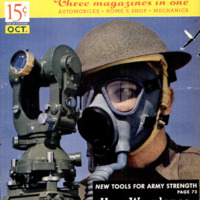 Popular Science Monthly, v. 139, n. 4, 1941
Popular Science Monthly, v. 139, n. 4, 1941

